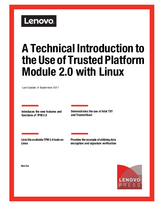Author
Updated
8 Sep 2017Form Number
LP0599PDF size
28 pages, 379 KBAbstract
The Trusted Platform Module (TPM) is a cryptographic component of many Lenovo® servers that provides additional security features. The TPM is an integral part of hardware-based security in Lenovo servers related to tasks such as user authentication, remote access, and data protection. System function such as Intel Trusted Execution Technology (Intel TXT) make use of TPM enhancements to help ensure system security.
This document covers a brief introduction to TPM 2.0 technology. It provides step-by-step instructions on how to enable TPM 2.0 on Lenovo servers running Linux. The document assumes the reader is already familiar with TPM 1.2 and the administration of Linux systems.
Table of Contents
Introduction
TPM 2.0 deployment
Using TPM 2.0 under Linux on Lenovo servers
Authors
Change History
Changes in the September 8 update:
- Grammar and style corrections
Configure and Buy
Full Change History
Course Detail
Employees Only Content
The content in this document with a is only visible to employees who are logged in. Logon using your Lenovo ITcode and password via Lenovo single-signon (SSO).
The author of the document has determined that this content is classified as Lenovo Internal and should not be normally be made available to people who are not employees or contractors. This includes partners, customers, and competitors. The reasons may vary and you should reach out to the authors of the document for clarification, if needed. Be cautious about sharing this content with others as it may contain sensitive information.
Any visitor to the Lenovo Press web site who is not logged on will not be able to see this employee-only content. This content is excluded from search engine indexes and will not appear in any search results.
For all users, including logged-in employees, this employee-only content does not appear in the PDF version of this document.
This functionality is cookie based. The web site will normally remember your login state between browser sessions, however, if you clear cookies at the end of a session or work in an Incognito/Private browser window, then you will need to log in each time.
If you have any questions about this feature of the Lenovo Press web, please email David Watts at dwatts@lenovo.com.

